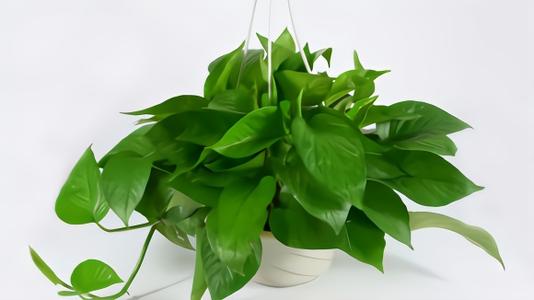How to Grow and Care Devils Ivy (Epipremnum Aureum)
Written by Maggie
Nov 15 2021

Devil's Ivy (Epipremnum Aureum), also known as the Golden ivy, is a tropical, evergreen vine native to the Solomon Islands that can be found anywhere from 10 to 12 in the USDA's outdoor cold tolerance zone or indoors as a hardy, comfortable indoor plant. In USDA Zone 9B, the plant may freeze to death in the winter, but usually reshoots in the spring. The needs of devil's ivy to grow, both indoors and outdoors, are fundamental, and it is relatively free of pests and disease, so even a black-thumb gardener should be able to use it successfully. In fact, plants thrive in the absence of care.

Devil Ivy - Most Common House Plant
How to grow Devil's ivy
Soil requirement of growing Devil's ivy
When planted outdoors, Devil's ivy thrives in a variety of soil conditions, from acidity to alkalinity, and can even survive where it is occasionally moist. If you are growing it in a container, a generic, well-drained peat potted mixture is enough to grow properly.
Light requirements for growing Devil's ivy
Devil's ivy grows outdoors in part to all shade, but when planted in deep shade it grows slowly, and the leaves lose their patches of color and become mostly green. If you are growing indoors, place it in an area that receives filtered sunlight or bright artificial light. (Find more air purifying house plants here.)
Fertilization for growing Devil's ivy
If you forget to fertilize Devil's ivy, don't worry because it's not very heavy fertilizer and it doesn't stop growing. However, you can fertilize both indoor and outdoor plants with universal liquid houseplant fertilizer. One or two applications during the growing season should be sufficient. Always follow the instructions and dosage on the label.
Read More:
Epipremnum Aureum (Golden Pothos) Growing & Propagation
Devil's ivy demand of water
Devil's ivy is highly drought-tolerant, so don't worry if your note reminding you to water your plants has been gone from your mind for weeks. Water Devil's ivy about once a week when it is growing, or when the top soil feels dry until it runs out of the drain at the bottom. In the winter, cut down on watering to about once every two weeks. Watering outdoor plants once a week is enough, but reduce the frequency to once every two weeks during the winter.
Read Next: How to Trim Devils Ivy

Devils Ivy is one of the plants that can grow in water
Landscape and interior uses of Devil's ivy
Devil's ivy has many uses in the landscape. You can let it climb trees to get the real tropical effect of its big leaves, hang it on a fence or wall, plant it in large containers and hanging baskets, or use it as a floor covering. Be careful when planting Devil's ivy near shrubs or hedges, as it has an aggressive growth tendency. Devil's ivy soon grows into shrubs or hedges and eventually takes over. Also note that Devil's ivy needs frequent pruning to keep it within a boundary when it is used as a ground. If you plant Devil's ivy about three feet apart.
Caring for Devil's ivy
In some places, Devil's ivy is invasive and smothers native plants.
Grown indoors, Devil's ivy adds lush green hanging baskets, table tops or trellis planting with additional vines.The trimmed parts can even grow in water containers, making this plant ideal for kitchen and bathroom environments. According to Floridata, one of the benefits of growing Devil's ivy as an indoor plant is that it removes some pollutants from the indoor air. Trim indoor Devil's ivy often with disinfecting trimmers to help control their size.
To prevent the spread of disease, before and after use, be sure to wipe the pruned leaf with a clean cloth or paper towel stained with rubbing alcohol and disinfect the pruned leaf.
The toxicity of Devil's ivy
All parts of Devil's ivy are poisonous, so keep the plant out of reach of children and pets. Also keep in mind that because some people have allergic reactions to SAP, you should consider wearing gloves when pruning plants. (Find more Vine Plants Indoor here.)

Read Next:
Best 20 Air Purifying House Plants Improve Your Health
20 Popular Vine Plants Indoor To Grow
Latest Updated
- Benefits of Bugleweed - 7 Science-backed Health Benefits
- Bugleweed Dangers & Side Effects - Is It Poisonous?
- How to Plant Evergreen Trees - What You Should Know
- When to Plant Evergreens - Grow Guide for Evergreen Trees
- 12 Wonderful Evergreen Shrubs for Your Garden
- 12 Popular Evergreen Plants with Pictures for Beginners
- When And How To Prune A Lilac Bush Like a Pro
- How to Grow & Care for Lilac Vine (Hardenbergia Violacea)
- Japanese Lilac Tree (Syringa Reticulata) Care & Propagation Guide
- Shumard Oak Pros and Cons - What to Know
Popular Articles
- Winter maintenance of Antirrhinum Majus
- How to Grow Terminalia Mantaly Tree
- How to Grow and Care for Crossostephium Chinense
- How to grow Antirrhinum Majus in spring
- Peristeria Elata (Dove Orchid) Profile: Info & Care Guide
- Underwatered Snake Plant (Sansevieria Trifasciata) - Signs And How To Fix
- How to Care for Brazilian Jasmine Plant (Mandevilla Sanderi)
- How to Grow & Care for Graptopetalum Purple Delight in Summer
- Rosa Chinensis (China Rose): Plant Growing & Care Tips
- How to Care for Baby Sun Rose (Aptenia Cordifolia)